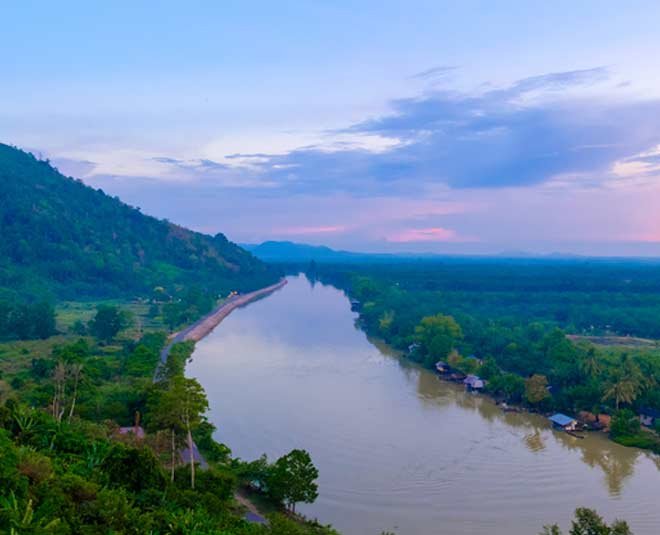Tapti River: The Forgotten River of Central India

The Tapti River also known as Tapi; is one of the leading rivers of Central India. Though geographically and historically important, a river like this remains less renowned than some other famous rivers in the region, such as the Narmada or Godavari; hence, it has been named the “Forgotten River.” Consequently, passing through the states of Madhya Pradesh, Maharashtra, and Gujarat, the Tapti River has maintained communities and industries along its banks for centuries. Many of its waters feed into agriculture, irrigation, and hydropower as a source of regional economies and biodiversity.

The Tapti holds historical importance because it was used to mark ancient kingdoms’ boundaries and also served as one of the major trade routes. However, similar to most of the rivers in India, the Tapti is also facing some serious environmental issues nowadays, which are being created by the depletion and pollution of water resources through excessive extraction. This article will deal with the geographical route of the river, its historical significance, tributaries, challenges that it is facing nowadays, and efforts being made to keep the ecological balance.
Origin of the Tapti River
The Tapti River is in the Satpura Range in Madhya Pradesh near the town of Multai in the Betul district. It flows west for about 724 kilometres, and it is one of the smallest rivers in India flowing from east to west, just like the Narmada and Mahi rivers. Finally, the Tapti flows into the Arabian Sea through the Gulf of Khambhat in Gujarat.
The river’s catchment area spans approximately 65,145 sq. km. It covers parts of Madhya Pradesh, Maharashtra, and Gujarat and cuts across the entire region. All along its course, the river flows past such cities as Burhanpur, Bhusawal, and Surat, helping considerably with irrigation and providing water for them.

Main Tributaries of the Tapti
The Tapti River is fed by several tributaries, which are generally seasonal and dependent on monsoon rains for flow. Key resources include:
- Purna River
- Gomai River
- Arunavati River
- Girna River
The tributaries contribute significantly to the potential for agriculture in the region, primarily for cotton and wheat in Maharashtra. However, there are irregular patterns in the flow of water in the river, which floods during monsoon and goes dry for most of the year to hinder good management of the water at their disposal.
Mythological Significance of the Tapti River
The Tapti River holds a special significance in Hindu mythology as it is believed to be the daughter of Surya, the Sun God. Surya created Tapti to temper the scorching heat coming from his side, and she symbolizes nourishment and life support. This is why the river is held in sacred regard, and the people of this region worship it with rituals and prayers near the river banks, especially during festivals like Makar Sankranti.

The river is associated with Surya, which means purity, light, and energy —a feel that resonates in the collective psyche of the communities along its course. Many believe bathing in auspicious periods in this river will clean one’s sins and bring good fortune. The Tapti River also has an ancient temple and shrines, many of which lie upon its banks, which also attract pilgrims from nearby regions.
Historical Importance and Modern Usage
The Tapti has a depth of history. It used to serve as a natural boundary between the kingdoms and was an important trade route during the ancient and medieval periods. Along the banks of Tapti, like Burhanpur of the Mughal period, there used to be a bustle of trade and culture. It used to serve as an important posting for traders between the Deccan Plateau and North India, which helped the spread of Islamic art and architecture in the region.
During British colonial times, cotton and agricultural products were transported along the river through Bhusawal and Surat. The port city of Surat, then, growing near the mouth of the river, experienced growth as a trading centre with Europe and Southeast Asia. Thus, the Tapti has acquired an important role in shaping the economic geography of western India.

Today, the Tapti River serves several important roles:
- Irrigation and Agriculture: The river helps agriculture in Madhya Pradesh, Maharashtra, and Gujarat, where the most important crops are cotton, soybeans, and sugarcane.
- Hydropower and Water Supply: Dams like the Ukai Dam on the Tapti River provide hydropower and supply water to cities like Surat.
- Industry and Urban Growth: The banks of this river facilitate industrial activities, especially in Maharashtra and Gujarat.
Despite financial support, the Tapti River is under increasing pressure due to urbanization and industrial development, leading to pollution and reduced flow.
Environmental Concerns and Preservation Efforts
Like most rivers in India, the Tapti River is also suffering from environmental degradation from both natural and human-induced processes. Industrial pollution and agricultural runoff combined with slow regulated urban growth have slowly affected its ecological health. Fluctuations are seasonal in nature, and erratically undergoing monsoon patterns also add their own complexity to managing the given water resources.

Environmental Challenges
- Pollution from Industries: Many industries along the Tapti corridor, especially in Gujarat and Maharashtra, are discharging untreated sewage into the water, severely affecting its quality and harming aquatic life.
- Over-Extraction of Water: The growing demand for water in agriculture and industry has caused excessive extraction from the river and its tributaries, causing declining water ranges, especially at some stages in dry seasons.
- Flooding and Erosion: The Tapti River is one of the rivers affected by floods, and seasonal flooding during the monsoon period has been experienced. The floods have washed away crops and infrastructure and affected human settlements. The floods have also impacted soil erosion, leading to the degradation of agricultural land along the riverbanks.
- Biodiversity Loss: Pollution and changes in water quality have adversely affected the aquatic ecosystem of the Tapi River, threatening many species of fish and freshwater ecosystems.

Conservation Efforts and Initiatives
Several government and community-led initiatives have been implemented in response to the need to protect the river’s environment:
- River Clean-Up Drives: Local authorities have begun preparing measures to reduce pollution and raise awareness among businesses and residents about the importance of sustainable water use.
- Ukai Dam Management: Enhanced control practices at the Ukai Dam aim to optimise water releases, minimise the impact of floods, and ensure a steady water supply for agriculture and enterprise.
- Afforestation Programs: Planting trees alongside the riverbanks reduces soil erosion and promotes groundwater recharge, thereby mitigating floods.
- Community Participation: NGOs and local communities actively monitor water quality and promote conservation through education programmes.
While these efforts have yielded some positive results, sustained efforts and collaborative governance are needed to effectively address the river’s environmental challenges.

Conclusion
Though overlooked or overshadowed by the glittering plumes of more famous rivers, the Tapti River is an integral part of the rich history and culture of Central India. The geographical and historical landscape of India has seen various roles played by it, from ancient trade routes to Mughal period settlements and modern agriculture. The river is now, however, still under increasing environmental challenges such as pollution, water scarcity, and loss of biodiversity pointing to the urgency of preservation efforts.
Among the initiatives developed to restore its ecological balance are the construction of the Ukai Dam and several cleanup programs. However, restoring the Tapti would require a two-way approach from the governments, industries, and local communities in handling the issues confronting it. The river evolved from a historically important waterway to a modern-day lifeline for agriculture and industry as the priorities of the places it passed through changed.
The story of the Tapti reminds humankind of this fragile relationship between the development of humanity and nature. The motivation to sustain such practices would continue the lifelines of millions while preserving cultural and ecological significance for future generations. With constant effort and community participation, the Tapti will regain its importance as something more than an ignored river-it will be rediscovered as a veritable lifeline for the development of Central India as a whole.


